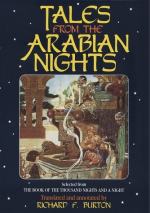Khafif, full or perfect form (sahih), both in Zarb
and ’Aruz
(Mac. N. ii. 356):
- U - - | U - U - | - U - - | Ya li-man ashtaki ’l-gharama ’llazi bi
U U - - | U - U - | - U - - | Wa shujuni wa furkati ’an habibi
O to whom now of my desire complaining sore shall
I * Bewail my
parting from my fere
compelled thus to fly (vol. v. 44).
Mujtass, the only ’Aruz (majzuah sahihah, i.e. shortened by one foot and perfect) with equal Zarb (Mac. N. ii. 367):
- - U - | U U - - | Ruddu ’alayya habibi
- - U - | - U - - | La hajatan li bi-malin
To me restore my dear * I want not wealth untold (vol. v. 55).
As an instance of the Munsarih, I give the second occurring in The Nights, because it affords me an opportunity to show the student how useful a knowledge of the laws of Prosody frequently proves for ascertaining the correct reading of a text. Mac. N. i. 33 we find the line:
- U U - | - U U - | - U U - | Arba’atun ma ’jtama’at kattu iza.
This would be Rajaz with the licence Mufta’ilun for Mustaf’ilun. But the following lines of the fragment evince, that the metre is Munsarih; hence, a clerical error must lurk somewhere in the second foot. In fact, on page 833 of the same volume, we find the piece repeated, and here the first couplet reads
- U U - | - U - U | - U U - | Arba’atun ma ’jtama’na kattu siwa
U - U - | - U - U | - U U - | Ala aza mujhati wa safki dami
Four things which ne’er conjoin unless it be
* To storm my vitals
and to shed my blood
(vol. iii. 237).
The Mutakarib, the last of the metres employed in The Nights, has gained a truly historical importance by the part which it plays in Persian literature. In the form of trimetrical double-lines, with a several rhyme for each couplet, it has become the “Nibelungen"-stanza of the Persian epos: Firdausi’s immortal “Book of Kings” and Nizami’s Iskander-namah are written in it, not to mention a host of Masnawis in which Sufic mysticism combats Mohammedan orthodoxy. On account of its warlike and heroical character, therefore, I choose for an example the knightly Jamrakan’s challenge to the single fight in which he conquers his scarcely less valiant adversary Kaurajan, Mac. N. iii. 296:
U - - | U - U | U - - | U - - | Ana ’l-Jamrakanu kawiyyn ’l-janani
U - - | U - U | U - - | U - - | Jami’u ’l-fawarisi takhsha kitali.
Here the third syllable of the second foot in each line is shortened by licence, and the final Kasrah of the first line, standing in pause, is long, the metre being the full form of the Mutakarib as exhibited p. 246, iii. E. 1. If we suppress the Kasrah of al-Janani, which is also allowable in pause, and make the second line to rhyme with the first, saying, for instance:
U — — | U
— U | U — — | U —
Ana ’l-Jamrakanu kawiyyu ’l-janan




